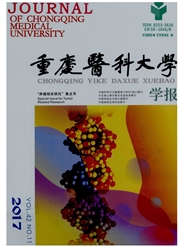

 中文摘要:
中文摘要:
目的:观察正常兔脑组织在不同剂量高强度聚焦超声(High intensity focused ultrasound,HIFU)作用后的反应和生存状态,探讨HIFU对脑部疾病治疗的可行性。方法:在总辐照时间不变的情况下,分组用不同的单次时间对24只新西兰兔脑组织进行定位损伤。观察实验兔的反应及生存状况,5周后处死取材,先用氯化三苯基四氮(triphenyl tetrazolium choloride,TTC)染色观察后,常规HE染色,光镜下观察组织学变化。结果:观察期内实验兔的生存状态在单次作用时间≥20s后明显变差,与作用次数无明显关系,组织学变化提示单次作用时间5~10s效果为最佳。结论:H1FU能有效定位损伤深部脑组织,单次作用剂量适宜时是安全的,而与作用次数无关。
 英文摘要:
英文摘要:
Objective:The purpose of this study is to determine if HIFU is feasible for the treatment of brain diseases by observing New Zealand Rabbits' reaction, living status and variation in microscope after different dosages of ablation. Methods:By using the same total time of HIFU exposure, we took different divided time to sonicate localized brain tissues of 24 New Zealand Rabbits for several times, to observe the rabbits' reaction and living status. All animals were sacrificed after 5 weeks. Then we applied TFC stain to observe the gross changesandHEstaint~ohservehistol~gicalchangesinmicr~sc~pe.Results:Duringthe~bservati~nperi~d~therabbits~ living status was apparently getting worse when the single exposure was I〉 20 second ( s ). The times of exposure were not correlated with living status. Ac- cording to our observation, the rabbits could tolerate the dose of HIFU exposure 〈 5W ~ 20s, hut histological and statistic study indicated that the best single exposure time was 5-10s. Conclusion:HIFU could ablate deep localized brain tissue with little effect on the superfi- cial tissue. The toleration to HIFU exposure for brain tissue is correlated with single dose of sonication, hut independent from times of ex- posure.
 同期刊论文项目
同期刊论文项目
 同项目期刊论文
同项目期刊论文
 期刊信息
期刊信息
